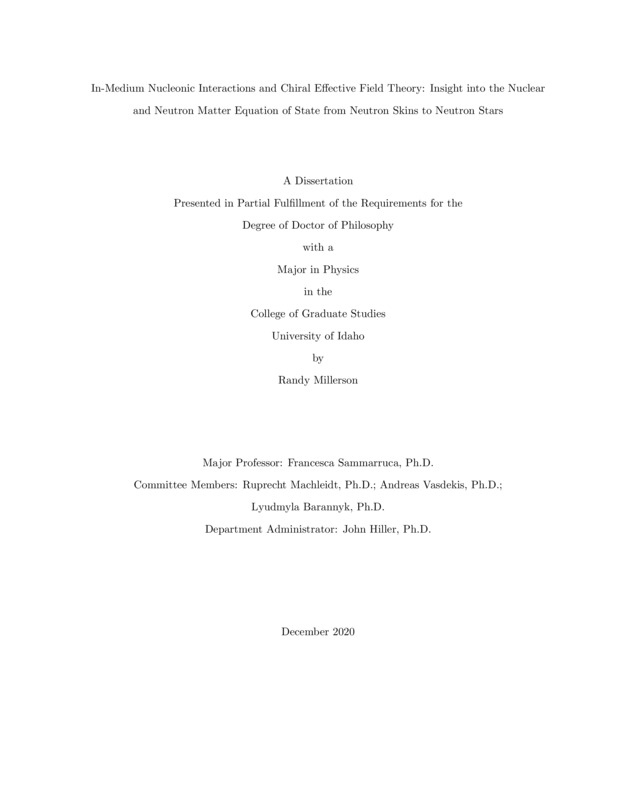In-Medium Nucleonic Interactions and Chiral Effective Field Theory: Insight into the Nuclear and Neutron Matter Equation of State from Neutron Skins to Neutron Stars
Millerson, Randy. (2020-12). In-Medium Nucleonic Interactions and Chiral Effective Field Theory: Insight into the Nuclear and Neutron Matter Equation of State from Neutron Skins to Neutron Stars. Theses and Dissertations Collection, University of Idaho Library Digital Collections. https://www.lib.uidaho.edu/digital/etd/items/millerson_idaho_0089e_11981.html
- Title:
- In-Medium Nucleonic Interactions and Chiral Effective Field Theory: Insight into the Nuclear and Neutron Matter Equation of State from Neutron Skins to Neutron Stars
- Author:
- Millerson, Randy
- Date:
- 2020-12
- Program:
- Physics
- Subject Category:
- Nuclear physics and radiation
- Abstract:
-
The goal of microscopic nuclear physics is to describe nuclear structure and nuclear reactions in terms of fundamental forces between the elementary constituents of hadrons.
Quantum Chromodynamics (QCD) is understood to be the fundamental theory of strong interactions. In QCD, hadrons are bound states arising from interacting quarks and gluons. Unfortunately, in the low-energy regime QCD is non-perturbative, which renders the theory unmanageable for the description of low-energy reactions and nuclear structure.
Chiral Effective Field Theory provides the link between QCD and nuclear forces that are suitable to describe bound nuclear systems and low-energy reactions. While respecting the symmetries of the QCD Lagrangian, the theory adopts nucleons and pions as its degrees of freedom. In this work we use two- and three-nucleon forces constructed from Chiral Effective Field Theory and apply them in nuclear matter. The energy per particle as a function of density in infinite nuclear matter is referred to as the nuclear matter equation of state.
Nuclear matter is an infinite system with equal densities of protons and neutrons. More precisely, this is referred to as ``symmetric nuclear matter." Neutron-rich matter is then an infinite system with larger concentration of neutrons, and, of course, pure neutron matter contains only neutrons. The many-body framework we use to evaluate the nuclear matter equation of state is known as the Bruckner-Hartree-Fock approach.
Having presented our theoretical tools for the development of the equation of state based on few-nucleon chiral forces (Chapter 2), we proceed to show and apply our predictions.
Modern theoretical predictions of neutron-rich matter are particularly timely. On-going and planned experiments aim at measuring observables which are sensitive to the equation of state of neutron-rich matter or pure neutron matter, particularly the neutron skin. Our predictions (Chapter 3) are within presently available empirical constraints.
The equation of state of neutron-rich matter has recently been brought to the forefront of nuclear astrophysics due its relevance for the properties of neutron stars. Neutron stars are important natural laboratories for constraining theories of the equation of state, because the mass-radius relationship of these stellar objects has been shown to be sensitive to it. Our calculations and predictions of neutron star radii are presented in Chapter 4. We find them to be in good agreement with recent observational constraints.
We conclude this work with our most recent effort, where we calculate the nuclear matter equation of state with the inclusion of subleading contributions to the chiral three-nucleon force. Additional studies related to this development are in progress.
- Description:
- doctoral, Ph.D., Physics -- University of Idaho - College of Graduate Studies, 2020-12
- Major Professor:
- Sammarruca, Francesca
- Committee:
- Machleidt, Ruprecht; Barannyk, Lyudmyla; Vasdekis, Andreas
- Defense Date:
- 2020-12
- Identifier:
- Millerson_idaho_0089E_11981
- Type:
- Text
- Format Original:
- Format:
- application/pdf
- Rights:
- In Copyright - Educational Use Permitted. For more information, please contact University of Idaho Library Special Collections and Archives Department at libspec@uidaho.edu.
- Standardized Rights:
- http://rightsstatements.org/vocab/InC-EDU/1.0/

